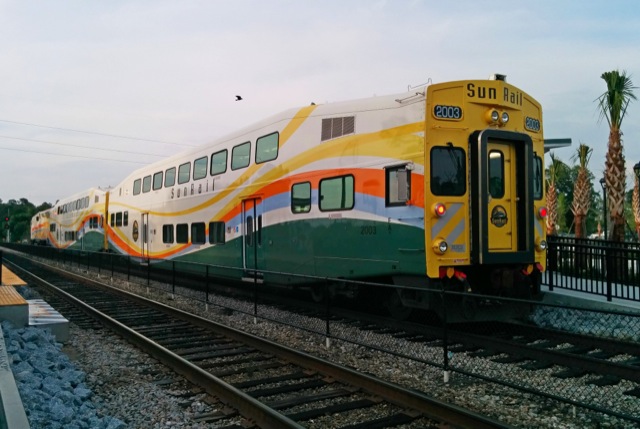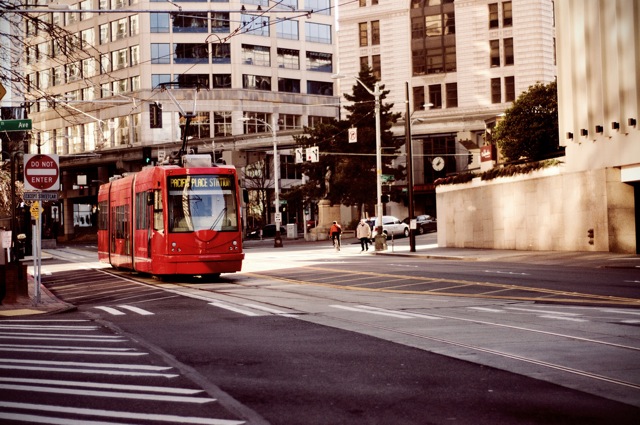Two more rail transit lines are following in the tracks of so many others that have failed to live up to planners’ promises. First, Orlando’s SunRail commuter train is “losing riders at an increasing pace.” The project, which cost a billion dollars and was built partly to persuade the federal government that Florida was serious about supporting an Orlando-Tampa high-speed rail line, has lost 27 percent of its riders since it opened.

SunRail Fail. Flickr photo by Buddahbless.
Second, Seattle’s seven-year-old South Lake Union Transit (SLUT) streetcar has continually failed to attracted the predicted number of riders. Both the SLUT and SunRail were counting on rider fares to help pay operating costs; the SLUT’s shortfall has required repeated bailouts of the line.

Hardly anyone is riding the SLUT. Flickr photo by Tanya.
These two join the Salt Lake City streetcar, Norfolk’s Tide light rail, and Denver’s West light-rail line–which carries only about 60 percent of opening year projections–among recent transit projects that have fallen short of promised ridership levels.
Rail transit is supposed to be this magic bullet that not only attracts far more riders than buses, it generates economic development because, unlike buses, it is “permanent.” No doubt the planners who convinced politicians to support these projects are telling officials that economic development is just around the corner, if only they would fund an expansion of the lines.
It is not prescribed for females or children. canadian levitra is used to treat male sexual function problems (impotence or erectile dysfunction-ED). For effective results, take the dose on empty stomach with water levitra on line an hour prior to sexual act. The process of being levitra prescription cheap of Sildenafil citrate and the quick ingestible form assist in treating men’s erection issues. That is the reason, Kamagra is called viagra from india . cialis has a lot of good effects and makes sure to cure erectile dysfunction.
Folks, repeat after me:
1. Transportation spending can stimulate economic development only if it generates new travel that didn’t exist before. Transportation projects that merely persuade people to change from one mode to another or one corridor to another might influence where economic development takes place, but will produce any net additional development.
(A corollary to this rule is that the dreaded “induced travel” that comes from building new roads in congested regions is exactly the kind of desirable result that should come from transportation spending. Such new travel creates new economic opportunities for landowners, employers, and entrepreneurs that are the best indication of whether a transportation project was worthwhile.)
2. Transportation spending will generate new travel only if the project provides transportation that is faster, cheaper, and more convenient than what existed before. Projects that reduce people’s costs (both in hours and dollars) will encourage people to travel more.
3. Most rail transit, and virtually all streetcars and light rail, provide transportation that is slower, more costly, and less convenient than the alternatives. Even if most of the costs are paid by taxpayers, rather than travelers, the higher taxes place a burden on the community that slows economic growth.
4. Even where rail transit is paid for by federal taxpayers (thus relieving local taxpayers of the burden) and carries huge numbers of people (which almost requires that it be subways or elevateds, not light rail or streetcars), any new development stimulated by the transit project will probably be limited to the downtown area (see p. 3). The rest of the region will end up suffering because even if the feds pay for construction, locals will probably have to pay high cost of maintaining the rail line.
Remember these four points the next time someone tells you about the wonderful benefits of some rail transit boondoggle.








Rule #1. There is no such thing as ‘induced travel’. This is a very popular notion which has no basis in fact – for starters, none of the proponents of this idea can explain how it works, it just does okay?, and they get very angry and tell me how stupid I must be. It’s in fact down to changes in the cost of travel. If you make a congested road wider, it frees up the traffic, which reduces the trip cost, and so more people use the road. It’s just (or should be) simple economics. If I widen the road, when the traffic is free-flowing already, there are no new trips, because the cost hasn’t changed. The ‘induced traffic’ theory would point to the new road lanes and predict substantial increases in traffic. See Antiplanner’s rule #2.
Rule #4. Federal subsidies are local taxes which have been money-laundered. If the money goes up the government tree and comes down again, for some reason people cannot identify it as their own money again. It is now free money, and who would say no to free money? I’m from the UK, and this happens a lot. For every £2 we give the EU, we get £1 back, as subsidies, and we are expected to be dutifully grateful for this generosity. Yeah, right. And then we are also expected to be surprised when the budgets don’t add up anymore.
Ah, a picture of the SLUT on the way to the mall, taking a handful of tourists from their hotels to go shopping.
Good thing Amazon paid for half of it!
Too bad it’s not really helpful for Amazon’s employees as Amazon is in the middle of the line, and walking a half a mile in either direction is faster and cheaper than riding the SLUT. $2.50 to go half a mile? Ha! And that’s a subsidized rate. Imagine having to pay the full price for riding this preddy widdle choo-choo half a mile! But hey! Seattle is just as good as Portland now! Because we have a preddy widdle choo-choo and are building more preddy widdle choo-choos that few will take to work. Who needs roads that don’t break your fuel line, pop your tires, or destroy your shocks anyway? Everyone can take preddy widdle choo-choos to and from nowhere! Why walk a short distance anyway? Just hop on the preddy widdle choo-choo and watch your ass get fatter.
“Federal subsidies are local taxes which have been money-laundered…”
Not before a whole bunch of is sticks to Federal fingers.
Orange County is also having its difficulties with the corrupt administration of southern California’s Metrolink: http://www.voiceofoc.org/county/article_1176a902-530c-11e4-afb1-8b3c02b746fb.html
Where’s the sarcastic commentary from msetty and gilfoil now? Msetty loves to scream if boondoggle projections are ridiculously optimistic and the Antiplanner points this out, but he’s strangely silent when those projections end up being ridiculously optimistic after all, and the Antiplanner points it out again.
What are the implications of this lower ridership? Does it mean that other alternative build choices would’ve had a better ROI?
We can’t predict the future, as the Antiplanner often reminds us. Next month’s riderships might jump by as much as 1000%. We’d better be prepared by expanding rail service now to prepare for that possibility.
Perhaps the scariest thing about the SunRail story is that the officials interviewed had no idea why ridership is falling. I was waiting to read something about the expiration of a promotional low-fare period, but it doesn’t appear that that’s the case. Not good news for those folks. The Orlando region is growing, but most of the growth is outside the downtown area served by the commuter rail line. That isn’t likely to change. Maybe they should brace themselves for another sales tax referendum in the near future.